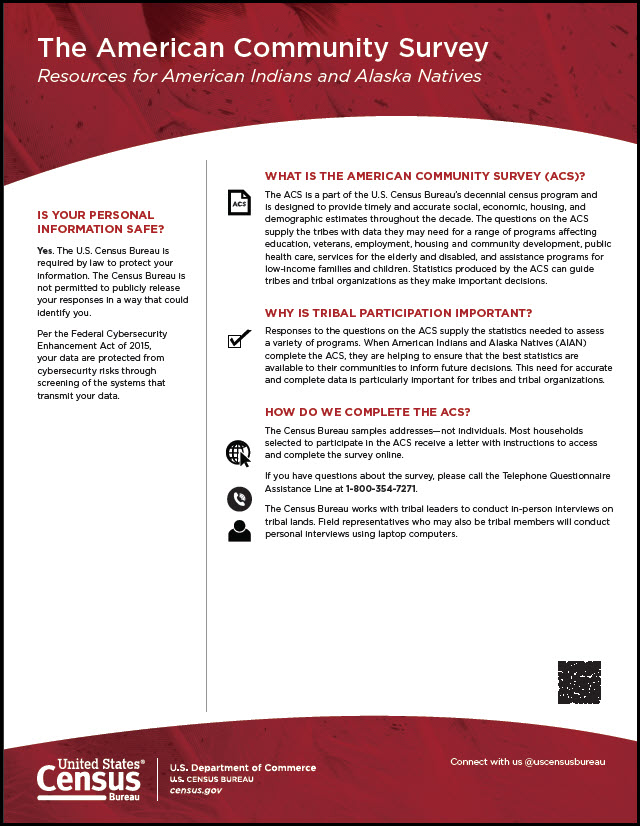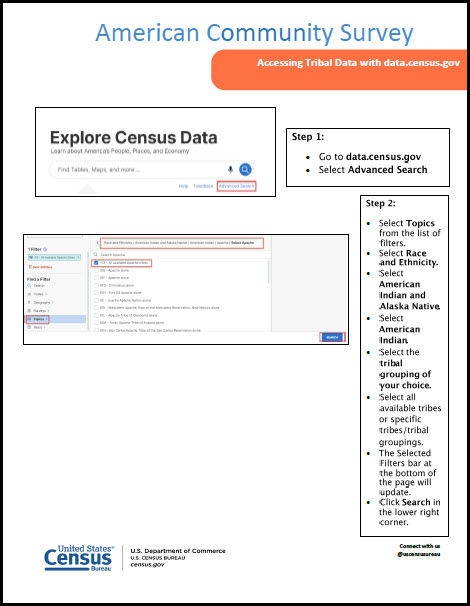American Community Survey Resources for American Indian and Alaska Native Populations
American Community Survey Resources for American Indian and Alaska Native Populations
The U.S. Census Bureau's American Community Survey (ACS) is an ongoing survey that provides vital information on a yearly basis about our nation and its people. Information from the survey generates data that help inform how trillions of dollars in federal funds are distributed each year. ACS data are also used in federal, state, and local programs to assist tribal governments.
Tribal government officials: We need your help!
Encourage people to respond to the American Community Survey. The ACS is sent to a small number of addresses and the responses represent the entire community. Participating in the ACS is very important and every response improves the quality of our data.
Explore this page for resources that American Indian and Alaska Native (AIAN) populations may find useful to understand and access the ACS, including training materials, information about responding to the survey, and ways to find data.
Background ACS Information for AIAN Communities
For federal American Indian reservations, the Census Bureau contacts representatives of federally recognized American Indian tribal governments to identify the boundaries for federal reservations through its annual Boundary and Annexation Survey (BAS). Federal reservations may cross state and all other area boundaries within the United States.
The ACS is self-response, which means that the Census Bureau does not assign American Indian or Alaska Native (AIAN) affiliation to respondents. Rather, respondents define their race and state their affiliated tribe.
The Office of Management and Budget (OMB) standard defines American Indian or Alaska Native for statistical purposes as “person having origins in any of the original peoples of North and South (including Central America) who maintains tribal affiliation or tribal community attachment.”
This includes people who:
- Indicate their race as “American Indian or Alaska Native”, or
- Report the name of their enrolled or principal tribe, or
- Report the name of their Indian group.
Respondents who identify themselves as “American Indian or Alaska Native” are asked to report their enrolled or principal tribe. Therefore, tribal data in tabulations reflect the written entries reported on the questionnaires. The information on tribe is based on self-identification and therefore does not reflect any designation of federally or state-recognized tribe.
The American Community Survey uses three modes of data collection over a three-month period: paper questionnaires through the mail, an Internet response option, and personal visits with a Census Bureau interviewer.
Special procedures exist to increase the sampling rates for AIAN Areas:
- Reallocate the sample with the goal to produce more even quality across smaller geographic areas, including many American Indian and Alaska Native Areas
- Higher overall sample size
- Attempting a personal visit interview for all cases in most American Indian and Alaska Native Areas, compared to most areas of the country where we attempt to follow-up with only a sample of eligible cases
Support the:
- Civil Rights Act
- Home Mortgage Disclosure Act
- Indian Health Care Improvement Act
- Native American Programs Act
- Public Health Service Act
- Veterans Benefits Improvement Act
- Workforce Investment Act
Administer:
- Federal Affirmative Employment Plans
- Higher Education and Student Assistance Programs
- National Affordable Housing, Subchapter I
- Nutritional Education Program
- State Children's Health Insurance Program
Top ACS Resources
The ACS Information Guide provides an overview of the history of the ACS, its data collection process, data topics, and more. The ACS Handbook for American Indians and Alaska Natives provides a deeper dive than the Information Guide and also includes case studies on how tribal populations use the ACS. Finally, our three flyers provide downloadable ACS resources for the AIAN community as well as instructions for accessing ACS data in data.census.gov.
Explore our Webinars
-
WebinarAmerican Indians and Alaska Natives and the American Community SurveyLearn more about the American Community Survey (ACS) and data available for American Indians and Alaska Natives. -
Webinar2017-2021 ACS 5-Year Selected Population Tables & AIAN TablesThis pre-release webinar discusses data ahead of the embargo of new 2017-2021 American Community Survey 5-year Selected Population Tables and AIAN Tables.
Respond to the ACS
Responding to the ACS is crucial for quality data that helps direct trillions of federal spending for programs that help your community every year. Please encourage others to respond when selected, and visit the links below to learn more.
-
Respond to the ACSLearn the different ways to respond to the American Community Survey -- online, by phone, by email. Read our FAQs or call us for more help with the survey. -
For People Living in Group QuartersLearn about our ACS Group Quarters (ACS GQ) data collection process for people in nursing homes, correctional facilities, and other group living arrangements. -
Sample ACS & PRCS Forms and InstructionsBrowse sample American Community Survey questionnaires in English and Spanish with instruction guides - 1996 through present. -
Are You in a Survey? Help for Survey ParticipantsIf you have received a survey, this site will help you verify that the survey came from us, understand and complete the form, and know how we protect your data.
Access ACS Data for AIAN Communities
There are many ways to access ACS data. Try the most popular tools or visit the ACS Data page for the full list.
-
Race, Ethnicity, Ancestry and American Indian & Alaska Native TablesAccess American Community Survey data and documentation for detailed race, Hispanic origin, tribal, and ancestry population groups. -
My Tribal AreaAccess selected statistics collected for the American Indian and Alaska Native (AIAN) population from the American Community Survey (ACS). -
QuickFactsQuickFacts provides frequently requested Census Bureau information at the national, state, county, and city level. -
data.census.govData.census.gov is the Census Bureau's main data dissemination platform. -
Census Business Builder (CBB)Census Business Builder offers small business owners selected Census Bureau & other statistics to guide their research for opening or expanding their business.
Questions? Contact us to Learn More.
Check out our FAQs, get in touch with Intergovernmental Affairs for a tribal affairs specialist, request a training or assistance with a local Data Dissemination Specialist, or contact us to learn more.
-
Frequently Asked QuestionsLearn more about the ACS through our answers to our Frequently Asked Questions. -
Intergovernmental Affairs: Tribal AffairsThe Tribal Resource (AIAN) website highlights the Census Bureau's relationship with tribal governments and provides important AIAN and tribal resources. -
Request a TrainingRequest a training from our team of Data Dissemination Specialists who can provide trainings, workshops, and presentations at no cost. -
Contact UsLearn how to contact the American Community Survey if you have questions about completing the survey, finding data, or using data.
There are many ways to access ACS data. Try the most popular tools or visit the ACS Data page for the full list.









